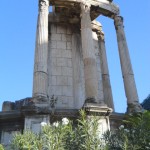Some years ago, an old woman came up to me, handed me two pennies, and said, “Go to Rome.” Then last summer, on my first visit to Rome, I found myself with Livia dancing along the Sacra Via.
There was the aura of Rome’s past glories, the romance of its ruins, and its monuments of the history and culture of the Eternal City. As the name implies, the Sacra Via passes along some of the holiest sites of Roma antica. By the end of Numa Pompilius’ reign, there stood the Temple of Vesta, the House of the Vestal Virgins, the Temple of the Lares beside which was the tabernaculum used by Numa in taking auspices, and the Domus Regia in which Numa lived, where the underground altar of Ops and a sacrarium of Mars were located. Passing through the Forum the Sacra Via passed by the Curia Hostilius, the commitium, and the rostrum of the Roman Republic. It passed by the Temple of Castor and Pollux, and the Volcanalis where Jupiter struck down Rex Tullus Hostilius for his hubris. Turning into the Clivus Capitolium one passes before the Temple of Saturn and other shrines before you would come upon Rome’s greatest temple, the Capitolium of Jupiter Optimus Maximus, Juno Regina, and Minerva.
The Sacra Via of Rome reflects another Sacred Way, too.

“Across the height of heaven there runs a road,
When skies are bared clear,
A path is well defined on high, which men,
Famed for its sheen of white, have named the Milky Way.
The immortals take passage along its way above,
With throngs awaiting before their doors flung wide open,
On the way to regal mansions of Jupiter Tonans.
On either side of its wide way the noble Gods are seen,
The lesser Gods make their abode in other parts,
but there the potent and renowned of Heaven
have set up the Penates of their homes. —It is a glorious place,
if audacious verse may allow – “High Heaven’s Palatine.”
~ Ovid, Met. Bk I
The historical and religious significance of the Sacra Via is thus very great in the Religio Romana. For some it is enough to walk along its worn stones. But dancing along the Sacra Via beneath the Gods of Rome holds greater significance.

The other day I was writing about some of the material offerings used as oblations in the Religio Romana. The minor goddess Rumina, as one example, may receive a bowl of fruits with a libation of milk poured over it, either when asking or thanking her for aiding the healthy flow of mother’s milk for a new born infant. However, no offering of fruits of the earth or material objects is as great as sharing a part of yourself with the Gods. Music, poetry, hymns, plays, mimes, athletic feats and even orations and expositions on philosophy were all composed in ancient times for the entertainment of the Goddesses and Gods. In fact, no formal Roman ritual is properly performed without the presence of music. This, too, is a form of giving back to the Gods something of the gifts that They lend to us. Our artistic skills are performed on behalf of the Gods as a type of oblation. And there was thought to be no greater form of worship than to dance before the Gods.
“Ceres, for You in breathless dance we your silent votaries do not cease (Statius, Silvae 8.45-54).”
Some of the Gods and Goddesses were known for Their dance skills. Minerva, for example, was called “the most virtuous dancer (Scriptores Historiae Augustae, Vita Probi c. 12.7).” Hercules was known for attending festivals at which He famously competed in drinking contests, demonstrated His athletic prowess, and was invited to “dance at Your holy rites with skillful feet (Virgil, Aeneid VIII.301-2).”

In the countryside Virgil encourages us to “foot the rugged dance and chant the lay (Georgics 1.350). For some festivals mimes were hired to dance bawdy comedies with titles such as “Signore Moon, Diana Flogged, Jove’s Last Testament, and the comedy of the Three Hungry Hercules (Tert. Ad Nat. 15).” But the very elite of Rome and their children also performed in dance along the Sacra Via. Once there was even a high official, praetor L. Furius Bibaculus, called upon by his father to dance among the Salii along the streets of Rome (Val. Max. 1.1.9). This was the same in cities elsewhere throughout the Roman Empire. “At Delos,” said Lucian, “not even the sacrifices are offered without dancing… Boy choruses assembled and, to the pipe and cithara, some moved about, singing, while the best performed a dance in accompaniment (De Salt. 16).” And Lucian also tells us that “People of the very best lineage and foremost in every city dance, not in the least embarrassed but proud of it (Lucian, De Salt. 79).”

Propertius, a pious man, once said that others might bring whole herds to slaughter in sacrifice before the Gods, or offer tributes of gold and spices from far off exotic lands whenever they come to court a favor from the Gods. But in giving thanks to the Gods for all he had received, “For me it shall be enough if I am able to dance along the Via Sacra in praise of the Gods (Prop. 3.4.22).” I have always told my students that if ever they wonder what is appropriate to offer, then dance. And if ever in ritual one does not know how to continue, then dance. This is because in dance we invoke a God or Goddess to join with us, enter us, imbuing us with the divine so that in ritual we might experience Their presence. And so Livia and I were gleefully dancing in happy thankfulness to the Gods for an old woman’s two coins and for her oracle bringing us to that moment along the Sacra Via of Rome.

















